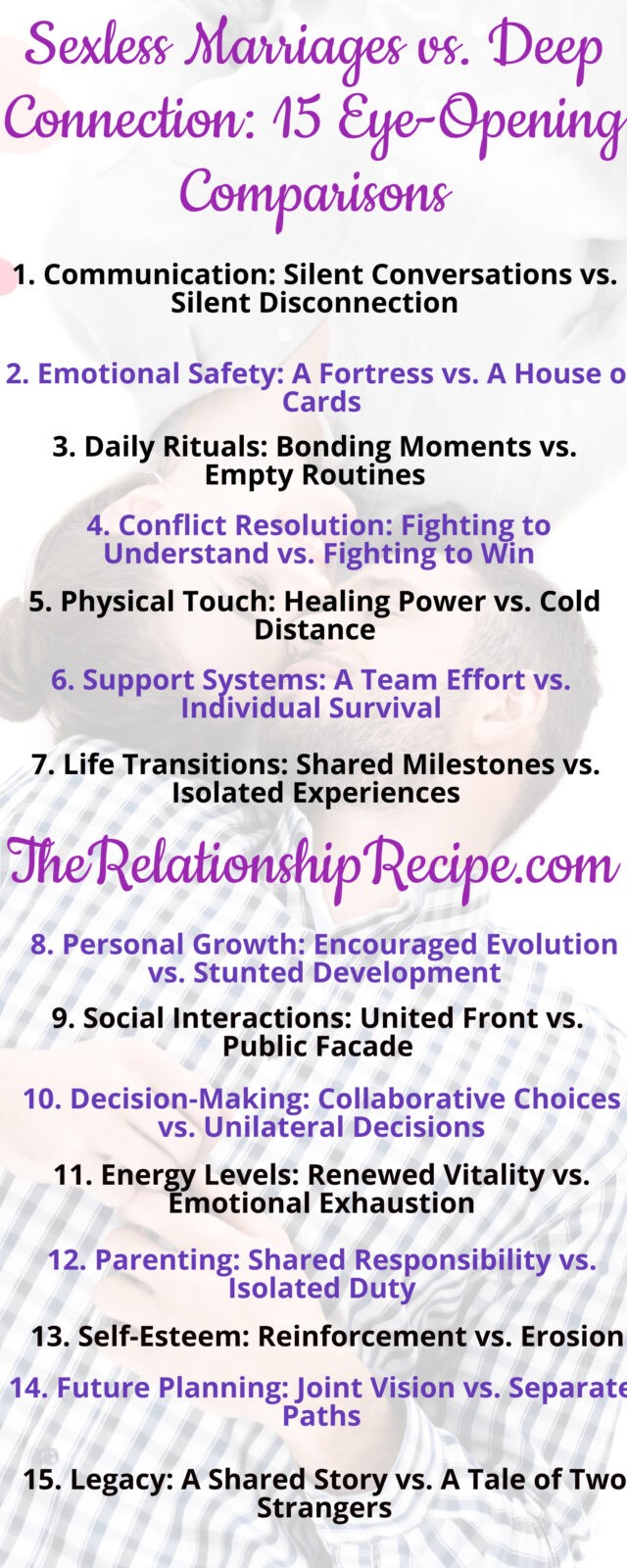When people think of sexless marriages, they often envision a relationship drained of passion, connection, and intimacy…that deep connection that we all crave. But the reality is more complex. Deep connection unions aren’t just about frequent physical intimacy.
The differences between these two types of relationships go beyond the obvious, impacting everything from emotional health to day-to-day dynamics in ways many don’t immediately recognize.

Some People Leave Their Sexless Marriages
Some people decide they just can’t take it anymore and decide to leave. I wrote a post about this phenomenon here. I’ve heard for years now, that at least 10-20% of marriages are considered sexless, but I believe it to be much higher.
There are entire groups on Facebook and Reddit showcasing the dead bedroom issue in all it’s crippled wonder. It’s depressing to read the anguish these partners are going through, because so many of us can relate.

According to Bed Bible:
Key Statistics
- 15.6% of Married Individuals Reported No Sexual Activity in the Past Year: This is a significant increase from just 1.9% in 1994.
- 74.2% of Sexless Marriages Result in Divorce: The majority of marriages without sex end in separation.
- 20.4 Million People in the U.S. Are in Sexless Marriages: A substantial number of individuals live in marriages without sexual intimacy.
- Married Couples Under 30 Engage in Sexual Activity 111 Times a Year: This equates to just over twice a week.
- Couples Married Over 30 Years Are 35 Times More Likely to Experience a Sexless Marriage: Compared to those newly married (within the first two years).
- 77% of Individuals in Sexless Marriages Desire More Sex: A majority of people in these marriages want to increase sexual frequency.
- Top Two Reasons for Declining Sexual Activity: Diminishing excitement and long work hours are the primary factors.

Sexual Activity by Length of Marriage
Not every group or newlywed couple faces these high percentages, but trends show:
- 5.6% of Marriages Lasting 0-10 Years Are Sexless: The incidence of sexlessness is relatively low in the early years.
- 13.7% of Marriages Lasting 10-20 Years Are Sexless: The rate increases as marriages reach their second decade.
- 20.1% of Marriages Lasting 20-30 Years Are Sexless: A significant rise in sexless marriages occurs after 20 years.
- 28.9% of Marriages Lasting 30-40 Years Are Sexless: Nearly one-third of couples in this duration experience a sexless marriage.

Let’s dive into 15 eye-opening comparisons that shed light on what truly separates sexless marriages from deeply connected unions.
1. Communication: Silent Conversations vs. Silent Disconnection
In deeply connected unions, silence can speak volumes. Partners in these relationships often share a deep understanding, where they don’t need words to communicate their feelings.
In contrast, sexless marriages are typically characterized by a painful silence that signifies disconnection. The lack of physical intimacy regularly parallels a lack of verbal and emotional communication, creating a gap that grows wider over time.

2. Emotional Safety: A Fortress vs. A House of Cards
Deeply connected couples create an emotional fortress, a safe space where vulnerabilities are shared and respected. They know their partner has their back, whether in or out of the bedroom.
In sexless marriages, this emotional safety typically crumbles, replaced by a house of cards that easily collapses under the weight of unspoken resentments and unmet needs.

3. Daily Rituals: Bonding Moments vs. Empty Routines
In a deeply connected relationship, even the smallest daily rituals, like making coffee together in the morning or texting throughout the day, serve as bonding moments. These couples infuse their daily lives with meaning.
Conversely, in sexless marriages, routines become empty motions, carried out with a sense of duty rather than love. The absence of physical intimacy typically mirrors an absence of connection in everyday activities.

4. Conflict Resolution: Fighting to Understand vs. Fighting to Win
Conflict in deeply connected unions isn’t about winning; it’s about understanding. These couples fight with the intention of resolving issues and growing closer.
In sexless marriages, conflicts frequently devolve into battles where the goal is to score points or prove a point, rather than to heal and move forward together.

5. Physical Touch: Healing Power vs. Cold Distance
Physical touch goes beyond sex in deeply connected relationships. A simple hug or a hand on the back can have a healing power, reinforcing the bond between partners.
In a sexless marriage, even non-sexual physical touch often diminishes, leading to a cold distance that feels impossible to bridge.

6. Support Systems: A Team Effort vs. Individual Survival
In deeply connected unions, partners operate as a team. They support each other’s dreams, share burdens, and work together toward common goals.
In sexless marriages, partners frequently find themselves in survival mode, fending for themselves emotionally and sometimes even financially, as the sense of partnership erodes.

7. Life Transitions: Shared Milestones vs. Isolated Experiences
Whether it’s buying a home, having children, or dealing with a crisis, deeply connected couples navigate life transitions together, celebrating successes and supporting each other through challenges.
In sexless marriages, these milestones can feel isolating. One partner may feel unsupported or emotionally detached during significant life events, further deepening the divide.

8. Personal Growth: Encouraged Evolution vs. Stunted Development
In deeply connected unions, personal growth is encouraged and celebrated. Partners inspire each other to become their best selves.
In contrast, sexless marriages can stunt personal development, as partners may feel stuck, unmotivated, or unsupported in their individual growth, leading to frustration and resentment.

9. Social Interactions: United Front vs. Public Facade
Deeply connected couples present a united front in social settings. Their bond is evident to others, not just through physical affection, but in the way they communicate and support each other.
In sexless marriages, social interactions often involve putting up a facade. The lack of intimacy at home can lead to strained or awkward dynamics in public, as partners try to mask the disconnect.

10. Decision-Making: Collaborative Choices vs. Unilateral Decisions
In deeply connected unions, decisions are made collaboratively, with both partners feeling valued and heard.
In sexless marriages, decision-making can become unilateral, where one partner dominates or disengages altogether, leading to further disconnection and dissatisfaction.

11. Energy Levels: Renewed Vitality vs. Emotional Exhaustion
Sex and intimacy regularly act as a source of energy and vitality in deeply connected relationships. These couples tend to have more enthusiasm and zest for life.
In sexless marriages, partners frequently feel emotionally exhausted and drained, lacking the energy that comes from a fulfilling intimate connection.

12. Parenting: Shared Responsibility vs. Isolated Duty
In deeply connected relationships, parenting is a shared responsibility. Partners work together, support each other, and present a consistent, united approach to raising children.
In sexless marriages, one partner may feel isolated in their parenting duties, leading to feelings of resentment and further straining the relationship.

13. Self-Esteem: Reinforcement vs. Erosion
In a deeply connected union, partners bolster each other’s self-esteem. They uplift and affirm each other, contributing to a positive self-image.
In sexless marriages, self-esteem often erodes as partners begin to feel unattractive, unloved, or unworthy, which can create a vicious cycle of disconnection.

14. Future Planning: Joint Vision vs. Separate Paths
Deeply connected couples plan their future together, creating a joint vision that excites and motivates them.
In sexless marriages, partners may begin to envision separate futures, either emotionally or physically, as the disconnect makes it difficult to imagine a shared path forward.

15. Legacy: A Shared Story vs. A Tale of Two Strangers
At the end of the day, deeply connected couples build a shared legacy. Their relationship is a story they’ve written together, full of shared experiences and mutual growth.
In sexless marriages, the legacy regularly feels like a tale of two strangers who happen to share the same roof, but not much else.

Conclusion
The contrasts between sexless marriages and deeply connected unions reveal that intimacy is about much more than physical connection. It’s woven into every aspect of the relationship, influencing how couples communicate, resolve conflicts, and grow together.
By understanding these deeper differences, couples can take steps to bridge gaps and build a relationship that thrives on every level.

This post may contain affiliate links. I earn from qualifying Amazon purchases at no extra cost to you.






